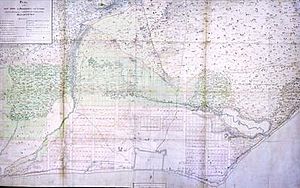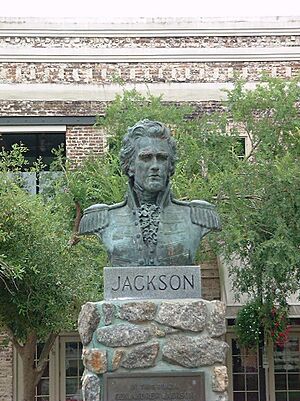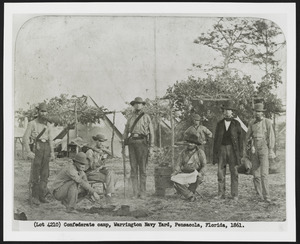History of Pensacola, Florida facts for kids
The history of Pensacola, Florida, is a long and exciting story. It starts thousands of years ago with Native American people living in the area. The modern city of Pensacola was founded by the Spanish in 1698.
Pensacola is special because it was the first place in what is now the continental United States where Europeans tried to build a lasting settlement. This happened in 1559, but it didn't last long. Over the centuries, Pensacola was controlled by different countries: Spain, France, Britain, and the United States. It even became part of the Confederate States of America for a short time.
Contents
- What's in a Name?
- Ancient Times: Before Europeans Arrived
- First Spanish Period (1559–1719)
- French Period (1719–1722)
- Second Spanish Period (1722–1763)
- British West Florida (1763–1781)
- Third Spanish Period (1781–1819)
- Before the Civil War (1821–1860)
- Civil War (1861–1865)
- After the War: The Late 1800s
- Recent History
- Images for kids
What's in a Name?
The city of Pensacola got its name from the Panzacola tribe. This Native American group lived near the bay when the Spanish first arrived.
In 1686, Spanish explorers Juan Enríquez Barroto and Antonio Romero visited the bay. They were looking for a lost French settlement. Juan Jordán de Reina, who was with them, wrote in his diary that the local Native Americans called the area "Panzacola." He thought the bay was "the best that I have ever seen in my life."
Ancient Times: Before Europeans Arrived
The first people to live around Pensacola Bay were Native American tribes. When Europeans first came, a tribe called the Panzacola (who spoke a language similar to Creek) had been living there for hundreds of years.
The area was great for hunting and fishing. Creek people from what is now southern Alabama and Georgia often visited to hunt, fish, and trade with the Pensacola tribe.
One important ancient site is Bottle Creek, located north of Mobile, Alabama. It has at least 18 large earth mounds, with five arranged around a central plaza. This was a common design for many mound-building cultures. Bottle Creek was a major ceremonial center for the Pensacola people from about 1250 CE to 1550 CE. People traveled mostly by dugout canoe through the waterways, as the land was covered in thick plants.
The written history of the area began in the 1500s when the first European explorers arrived. Explorers like Pánfilo de Narváez (in 1528) and Hernando de Soto (in 1539) visited Pensacola Bay. De Soto's group called it "Ochuse," after a local Indian area.
First Spanish Period (1559–1719)
European explorers started visiting the Pensacola area in the 1500s. In 1516, Diego Miruelo might have been the first European to sail into Pensacola Bay.
The first Spanish settlement attempt was large but didn't last. On August 15, 1559, Don Tristán de Luna y Arellano arrived with about 1,500 people on 11 ships from Mexico. This was the first European settlement in what is now the United States that lasted more than a year.
However, just weeks later, on September 19, 1559, a hurricane hit. It sank six ships, damaged another, and ruined supplies. The survivors struggled to find food. After two years, in 1561, the settlement was given up. The Spanish decided that northwest Florida was too dangerous to settle and mostly left it alone for 137 years.
In 1693, the Mexican Viceroy (a high-ranking official) sent General Andrés de Pez to explore the Gulf Coast. Carlos de Sigüenza y Góngora, a famous Mexican scientist, went with him. They reached Pensacola in April. The Spanish renamed Pensacola Bay "Bahía Santa María de Galve." Sigüenza wrote a very positive report, saying the area was full of food and good for building ships. He encouraged a new settlement.
The Spanish King agreed to the settlement in 1694. But because of a war in Europe (King William's War), they delayed settling Pensacola until 1698.
The Spanish finally resettled Pensacola in November 1698, led by Governor Andrés de Arriola. They built three forts (called presidios) in Pensacola over the next few decades:
- Presidio Santa Maria de Galve (1698–1719): This fort was called San Carlos de Austria. The French captured it in 1719. After a hurricane and a fire, the French burned the rest of the settlement before giving it back to the Spanish. It was then abandoned.
- Presidio Isla de Santa Rosa (1722–1752): This fort was on the western end of Santa Rosa Island. After hurricanes hit in 1741 and 1752, the settlers moved to the mainland.
- Presidio San Miguel de Panzacola (1754–1763): This final fort was about five miles east of the first one, in what is now downtown Pensacola. It was named after the Panzacola tribe.
The Spanish established Pensacola in 1698 to protect their land from the French, who were settling in Louisiana. The Spanish brought the Roman Catholic Church and tried to convert the Pensacola people and the African slaves they brought. People from different backgrounds married and had children, creating mixed-race families.
Life in early Pensacola was hard. The soil was poor for farming, and supplies were often late. Many people didn't want to be stationed there because of tropical diseases and heat.
In 1699, the French founded Mobile, Alabama, which was a threat to the Spanish. During Queen Anne's War (1702–1713), Creek Indians, allied with the English, attacked Pensacola several times. The Creek people severely damaged the Pensacola tribe, and survivors moved to Pensacola, Mobile, and St. Augustine. The French and Spanish then became allies against the English.
French Period (1719–1722)
On May 14, 1719, Jean-Baptiste Le Moyne de Bienville, the Governor of French Louisiana, captured Pensacola for France. The Spanish commander surrendered because he didn't know war had been declared and his forces were too small to fight. The French held Pensacola for a few years.
A hurricane forced the French to leave Pensacola in 1722. They burned the town before they left. The Spanish then moved the town from the storm-prone island to the mainland.
Second Spanish Period (1722–1763)
The area was rebuilt, but hurricanes hit again in 1752 and 1761. The population didn't grow much. During this time, Spanish missionaries worked with Native Americans, and Pensacola became an important port and military outpost. There were often conflicts with French and British interests. The biggest threat came from English pirates, smugglers, and traders who could sell goods more cheaply than the Spanish.
British West Florida (1763–1781)
After Britain won the Seven Years War (also called the French and Indian War) in 1763, they took control of Pensacola. During British rule, the area started to do well. The British made Pensacola the capital of British West Florida. They built up the fort area and created the current street plan for the town, including the Seville Square district.
During the American Revolution (1775–1783), Florida remained loyal to the British. Many Loyalists (people loyal to the British king) moved to Florida. Spain allied with the American rebels. In 1781, during the Battle of Pensacola, the Spanish attacked the British and captured West Florida. After the war, Britain gave East Florida to Spain.
Third Spanish Period (1781–1819)
The Spanish held Pensacola again from 1781 to 1821. It became a frontier town and trading post. European men often had families with Creek and African women, leading to mixed-race families.
The United States wanted control of the Mississippi River and New Orleans for trade. After the U.S. bought the Louisiana Territory from France in 1803, Spanish Florida was surrounded by American states. American settlers moved into West Florida, and Spain was busy with rebellions in Mexico and South America, so they couldn't protect the area well.
In 1810, American settlers in part of West Florida declared themselves independent from Spain. This area became part of Louisiana in 1812. General Andrew Jackson captured much of West Florida in the 1810s. He briefly returned Pensacola to Spain, but areas further west became part of Mississippi (1817) and Alabama (1819).
In 1819, the United States captured Pensacola again. In 1821, all of modern Florida was transferred to the United States. Pensacola was the largest city and most important port, so it became part of the new Florida Territory. This set the current borders of the state.
Before the Civil War (1821–1860)
In 1825, the area for the Pensacola Navy Yard was chosen. In 1827, the first permanent Protestant church was built.
The Pensacola area has three historic U.S. forts: Fort Barrancas, Fort Pickens, and Fort McRee. Barrancas National Cemetery is also here. Fort Pickens was finished in 1834 and was one of the few Southern forts held by the United States throughout the American Civil War.
Andrew Jackson was Florida's first governor when it became a U.S. territory. He lived in Pensacola. More Anglo-American settlers came, including many planters who brought their enslaved African Americans. To choose a capital city, riders from Pensacola and St. Augustine met in the middle at the Indian village of Tallahassee, which became the new capital.
Florida became the 27th state in the Union on March 3, 1845. Its entry was delayed because of conflicts with the Seminole Indians. After three Seminole Wars, many Seminoles were forced to move to what is now Oklahoma.
In Pensacola, the local economy grew rich from the lumber industry. There were many forests, a good harbor for shipping, and clever business people. Starting in the 1830s, steam power made sawmills much more efficient, producing finished lumber for export.
Civil War (1861–1865)
On January 10, 1861, Florida became the third state to leave the Union and join the Confederate States of America. Fort Pickens, one of the forts guarding Pensacola Bay, was held by Union troops. It was never captured by Confederate forces during the war.
In May 1862, U.S. troops took over Pensacola when Confederate General Braxton Bragg left. Most of the city was burned. Many residents moved inland to Greenville, Alabama.
The Confederate Secretary of the Navy, Stephen Mallory, was from Pensacola. He is buried in the city's historic Saint Michael's Cemetery.
After the War: The Late 1800s
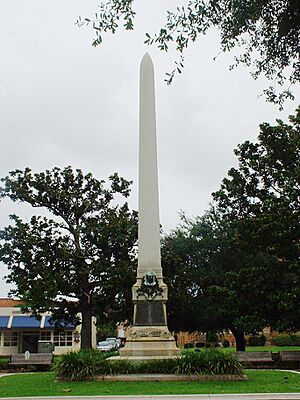
After the Civil War, the economy of the region was badly affected. While many white Confederate veterans faced difficulties, newly freed African Americans gained more political freedoms than ever before. Pensacola and Escambia County had more African-American political representation during this time than they would for many years. Florida rejoined the Union on June 25, 1868.
Later in the 1800s, Florida, like other Southern states, passed new laws that made it very hard for most African Americans to vote. They used things like poll taxes and literacy tests to stop them from participating in the political system.
Cotton farming was still important, but the South's focus on agriculture slowed its progress. In the early 1900s, a pest called the boll weevil destroyed cotton crops. Slowly, the economy started to change, and cities grew. Large pine forests became important for making paper. A brick-making industry also grew.
Shipping became less important, but military and manufacturing jobs grew. Fishing and seafood harvesting were also vital. The Historic Pensacola Museum of Industry tells the story of these industries.
Recent History
For many years, Florida and Pensacola had a segregated society due to Jim Crow laws. African Americans in Florida began a long fight to regain their civil rights, which grew stronger in the 1950s and 1960s.
In the 1970s, there were conflicts at Escambia High School in Pensacola as schools were desegregated. After some incidents, the school's mascot, a Confederate rebel, was changed to a gator.
Since the late 1900s, tourism has grown a lot, especially around the beaches. Many new buildings have been built on previously untouched beaches, particularly near Panama City, Fort Walton Beach, and Destin, Florida. This area attracts many tourists and new residents, despite occasional hurricane damage.
Many barrier island areas have been developed with condos and houses. This increases the risk of storm damage because these islands naturally shift. However, other areas remain undeveloped, and the Gulf Islands National Seashore is protected as a park.
Images for kids
-
The T. T. Wentworth Jr. Florida State Museum, built as the City Hall, is in the 19th-century mission style, reminiscent of the Alamo.
-
A bust of Andrew Jackson at the Plaza Ferdinand VII, where Jackson was sworn in as Governor.
-
General William Dudley Chipley helped rebuild Pensacola after the Civil War. An obelisk was put up in his honor.
Quick facts for kids History of Florida |
|
|---|---|
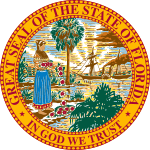
The seal of Florida reflects the state's Native American ancestry
|
|
| Historical Periods | |
| Pre-history | until 1497 |
| Spanish Rule | 1513–1763 |
| British Rule | 1763–1783 |
| Spanish Rule | 1783–1821 |
| U.S. Territorial Period | 1822–1845 |
| Statehood | 1845–present |
| Major Events | |
| American Revolutionary War | 1775–1783 |
| War of 1812 | 1811–1814 |
| First Seminole War | 1817–1818 |
| Capitol moved to Tallahassee |
1824 |
| Second Seminole War | 1835–1842 |
| Constitutional convention | 1838 |
| Third Seminole War | 1855–1858 |
| Ordinance of Secession | 1861 |
| Civil War | 1861–1865 |
| 3rd Constitution | 1865 |
| Reconstruction | 1865–1868 |
| 4th Constitution | 1868 |
| 5th Constitution | 1885 |
| Great Migration | 1910–1930 |
| Land Boom | 1925–1929 |
| 6th Constitution | 1968 |
| Gore v. Harris 2000 Presidential Election |
2000 |
| Timeline | |



